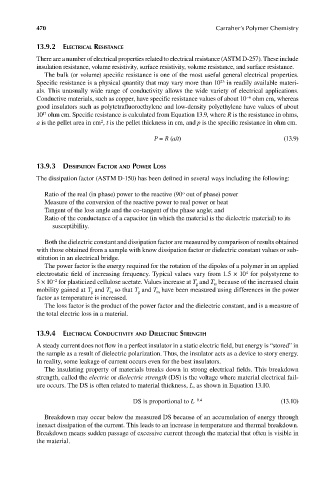Page 507 - Carrahers_Polymer_Chemistry,_Eighth_Edition
P. 507
470 Carraher’s Polymer Chemistry
13.9.2 ELECTRICAL RESISTANCE
There are a number of electrical properties related to electrical resistance (ASTM D-257). These include
insulation resistance, volume resistivity, surface resistivity, volume resistance, and surface resistance.
The bulk (or volume) specific resistance is one of the most useful general electrical properties.
23
Specific resistance is a physical quantity that may vary more than 10 in readily available materi-
als. This unusually wide range of conductivity allows the wide variety of electrical applications.
–6
Conductive materials, such as copper, have specific resistance values of about 10 ohm cm, whereas
good insulators such as polytetrafluoroethylene and low-density polyethylene have values of about
17
10 ohm cm. Specifi c resistance is calculated from Equation 13.9, where R is the resistance in ohms,
2
a is the pellet area in cm , t is the pellet thickness in cm, and p is the specific resistance in ohm cm.
P = R (a/t) (13.9)
13.9.3 DISSIPATION FACTOR AND POWER LOSS
The dissipation factor (ASTM D-150) has been defined in several ways including the following:
o
Ratio of the real (in phase) power to the reactive (90 out of phase) power
Measure of the conversion of the reactive power to real power or heat
Tangent of the loss angle and the co-tangent of the phase angle; and
Ratio of the conductance of a capacitor (in which the material is the dielectric material) to its
susceptibility.
Both the dielectric constant and dissipation factor are measured by comparison of results obtained
with those obtained from a sample with know dissipation factor or dielectric constant values or sub-
stitution in an electrical bridge.
The power factor is the energy required for the rotation of the dipoles of a polymer in an applied
4
electrostatic field of increasing frequency. Typical values vary from 1.5 × 10 for polystyrene to
–2
5 × 10 for plasticized cellulose acetate. Values increase at T and T because of the increased chain
m
g
mobility gained at T and T so that T and T have been measured using differences in the power
g
m
g
m
factor as temperature is increased.
The loss factor is the product of the power factor and the dielectric constant, and is a measure of
the total electric loss in a material.
13.9.4 ELECTRICAL CONDUCTIVITY AND DIELECTRIC STRENGTH
A steady current does not flow in a perfect insulator in a static electric field, but energy is “stored” in
the sample as a result of dielectric polarization. Thus, the insulator acts as a device to story energy.
In reality, some leakage of current occurs even for the best insulators.
The insulating property of materials breaks down in strong electrical fields. This breakdown
strength, called the electric or dielectric strength (DS) is the voltage where material electrical fail-
ure occurs. The DS is often related to material thickness, L, as shown in Equation 13.10.
DS is proportional to L −0.4 (13.10)
Breakdown may occur below the measured DS because of an accumulation of energy through
inexact dissipation of the current. This leads to an increase in temperature and thermal breakdown.
Breakdown means sudden passage of excessive current through the material that often is visible in
the material.
9/14/2010 3:42:18 PM
K10478.indb 470 9/14/2010 3:42:18 PM
K10478.indb 470

